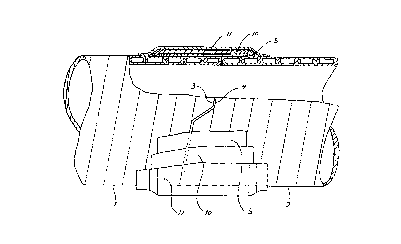Some of the information on this Web page has been provided by external sources. The Government of Canada is not responsible for the accuracy, reliability or currency of the information supplied by external sources. Users wishing to rely upon this information should consult directly with the source of the information. Content provided by external sources is not subject to official languages, privacy and accessibility requirements.
Any discrepancies in the text and image of the Claims and Abstract are due to differing posting times. Text of the Claims and Abstract are posted:
| (12) Patent: | (11) CA 2109582 |
|---|---|
| (54) English Title: | A METHOD FOR JOINING SPIRALLY WOUND THERMOPLASTIC PIPES TOGETHER |
| (54) French Title: | METHODE D'ASSEMBLAGE DE TUYAUX THERMOPLASTIQUES |
| Status: | Term Expired - Post Grant Beyond Limit |
| (51) International Patent Classification (IPC): |
|
|---|---|
| (72) Inventors : |
|
| (73) Owners : |
|
| (71) Applicants : | |
| (74) Agent: | MCCARTHY TETRAULT LLP |
| (74) Associate agent: | |
| (45) Issued: | 1998-09-15 |
| (86) PCT Filing Date: | 1992-06-12 |
| (87) Open to Public Inspection: | 1992-12-23 |
| Examination requested: | 1996-03-28 |
| Availability of licence: | N/A |
| Dedicated to the Public: | N/A |
| (25) Language of filing: | English |
| Patent Cooperation Treaty (PCT): | Yes |
|---|---|
| (86) PCT Filing Number: | PCT/FI1992/000185 |
| (87) International Publication Number: | WO 1992022419 |
| (85) National Entry: | 1993-11-19 |
| (30) Application Priority Data: | ||||||
|---|---|---|---|---|---|---|
|
The present invention relates to a method for joining spirally wound thermoplastic pipes (1, 2) of a hole profile together,
characterized by the following steps: working the end surfaces (3, 4) of the spirally wound thermoplastic pipes (1, 2) into a
smooth step-formed surface; setting two thermoplastic pipes (1, 2) end against end such that a smooth step-formed gap is formed
between the end surfaces (3,4); applying a stainless steel band (5) over the gap and heating the steel band (5) to ca. 100 °C,
applying an extruder (6) with a rotating extruder head (6) and a cooled slide and smoothing organ (8) cooperating therewith inside
the pipes (1, 2) to be joined together; heating the end surfaces (3, 4); extruding a weld seam of a melted thermoplastic (9) into the
gap between the two end surfaces (3, 4); as well as stopping the heating of the steel band (5) and removal of the steel band (5)
from the joining place after cooling.
La présente invention concerne un procédé d'assemblage de canalisations thermoplastiques de construction hélicoïdale (1, 2) comportant les étapes suivantes : découpage des extrémités des canalisations (1, 2) pour obtenir une face régulière avec épaulement(s) (3, 4); aboutement des canalisations (1, 2) de manière à laisser un espace entre les faces d'extrémité (3, 4); mise en place d'une bande d'acier inoxydable (5) sur le joint et chauffage de la bande d'acier à une température d'environ 100 oC; insertion dans les canalisations (1, 2) à assembler d'un dispositif d'extrusion (6) à tête rotative (6) avec caniveau et organe de lissage (8) refroidis; chauffage des faces d'extrémité (3, 4) à assembler; extrusion d'une matière thermoplastique fondue (9) dans l'espace entre les faces d'extrémité (3, 4) pour former un joint; arrêt du chauffage de la bande d'acier inoxydable (5) et retrait de la bande (5) après refroidissement du joint.
Note: Claims are shown in the official language in which they were submitted.
Note: Descriptions are shown in the official language in which they were submitted.

2024-08-01:As part of the Next Generation Patents (NGP) transition, the Canadian Patents Database (CPD) now contains a more detailed Event History, which replicates the Event Log of our new back-office solution.
Please note that "Inactive:" events refers to events no longer in use in our new back-office solution.
For a clearer understanding of the status of the application/patent presented on this page, the site Disclaimer , as well as the definitions for Patent , Event History , Maintenance Fee and Payment History should be consulted.
| Description | Date |
|---|---|
| Inactive: Expired (new Act pat) | 2012-06-12 |
| Inactive: IPC from MCD | 2006-03-11 |
| Inactive: IPC from MCD | 2006-03-11 |
| Inactive: IPC from MCD | 2006-03-11 |
| Inactive: IPC from MCD | 2006-03-11 |
| Inactive: IPC from MCD | 2006-03-11 |
| Inactive: IPC from MCD | 2006-03-11 |
| Grant by Issuance | 1998-09-15 |
| Pre-grant | 1998-04-14 |
| Inactive: Final fee received | 1998-04-14 |
| Notice of Allowance is Issued | 1998-03-03 |
| Notice of Allowance is Issued | 1998-03-03 |
| Letter Sent | 1998-03-03 |
| Inactive: Status info is complete as of Log entry date | 1998-02-25 |
| Inactive: Application prosecuted on TS as of Log entry date | 1998-02-25 |
| Inactive: IPC removed | 1998-02-09 |
| Inactive: IPC removed | 1998-02-09 |
| Inactive: First IPC assigned | 1998-02-09 |
| Inactive: IPC assigned | 1998-02-09 |
| Inactive: IPC assigned | 1998-02-09 |
| Inactive: Approved for allowance (AFA) | 1998-02-06 |
| All Requirements for Examination Determined Compliant | 1996-03-28 |
| Request for Examination Requirements Determined Compliant | 1996-03-28 |
| Application Published (Open to Public Inspection) | 1992-12-23 |
There is no abandonment history.
The last payment was received on
Note : If the full payment has not been received on or before the date indicated, a further fee may be required which may be one of the following
Please refer to the CIPO Patent Fees web page to see all current fee amounts.
Note: Records showing the ownership history in alphabetical order.
| Current Owners on Record |
|---|
| OY KWH PIPE AB |
| Past Owners on Record |
|---|
| GUNNAR BLOMQVIST |